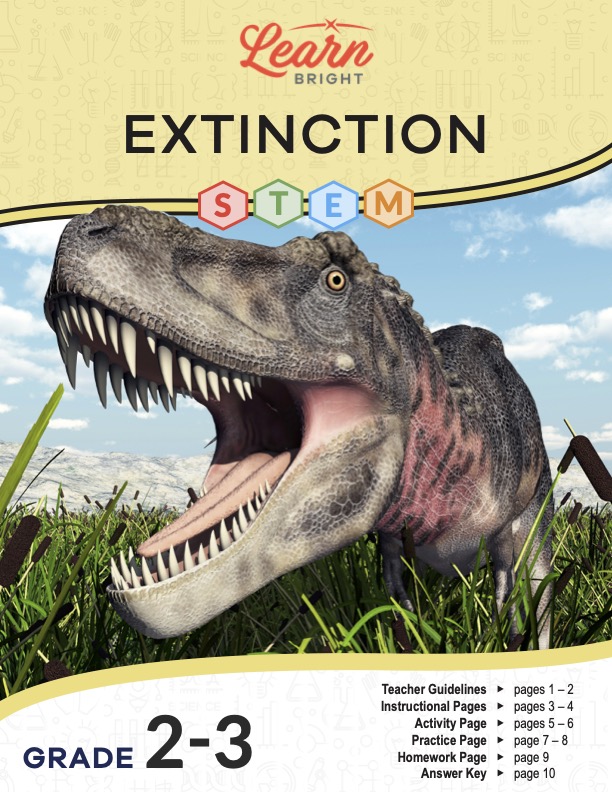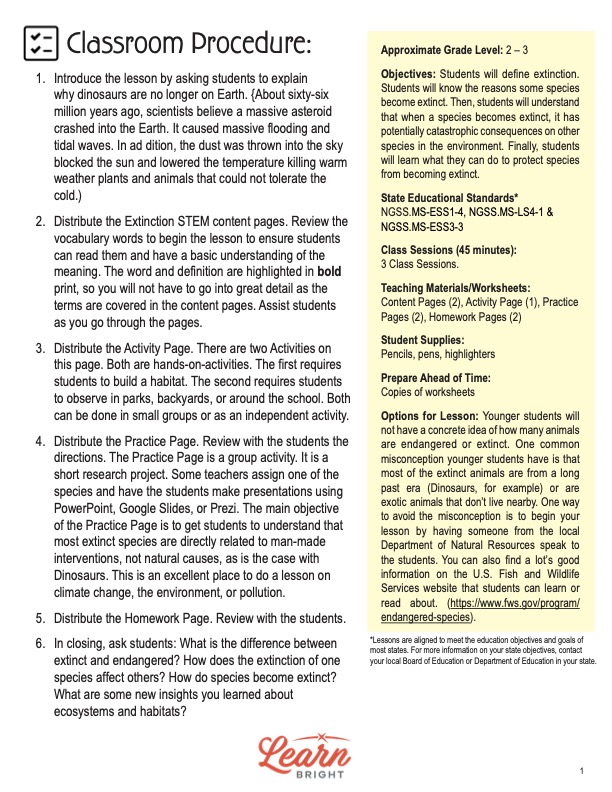Description
What our Extinction STEM lesson plan includes
Lesson Objectives and Overview: Extinction STEM explores the concept of extinction and why certain species die out. Students will discover that there are often major consequences to an environment or ecosystem when a species becomes extinct. They will also learn ways that they can help protect animals or other species from extinction. This lesson is for students in 2nd grade and 3rd grade.
Classroom Procedure
Every lesson plan provides you with a classroom procedure page that outlines a step-by-step guide to follow. You do not have to follow the guide exactly. The guide helps you organize the lesson and details when to hand out worksheets. It also lists information in the yellow box that you might find useful. You will find the lesson objectives, state standards, and number of class sessions the lesson should take to complete in this area. In addition, it describes the supplies you will need as well as what and how you need to prepare beforehand. This lesson simply requires writing utensils like pencils, pens, and highlighters.
Options for Lesson
The “Options for Lesson” section provides ideas for additional activities to add or incorporate into the lesson. This lesson provides one idea involving a way to start your lesson off. Younger students will not have a concrete idea of how many animals are endangered or extinct. One common misconception they have is that most of the extinct animals are from a long past era (e.g., the age of the dinosaurs) or are exotic animals that don’t live nearby. One way to avoid this misconception is to begin your lesson by having someone from the local Department of Natural Resources speak to the students. You can also find a lots of good information on the U.S. Fish and Wildlife Services website that students can learn or read about.
Teacher Notes
The paragraph on this page provides a little extra information on what you can expect from the lesson. It suggests showing the Learn Bright video on this topic sometime during the lesson. You could also teach this lesson at the same time as or before a lesson photosynthesis. Use the lines to write out your thoughts as you prepare.
EXTINCTION STEM LESSON PLAN CONTENT PAGES
Introduction to Extinction
The Extinction STEM lesson plan has three pages of content. Starting off, it tells students to observe and record the different plants, animals, and insects they see outside the window. (If your classroom has a window, it could be fun to have students take turns doing this. You could also take them outside for a few minutes and have them write down the things they see in the chart.)
There are many more organisms that we can’t see just by looking out a window. For example, some insects like worms live underground. Some animals only come out at night, like bats. If it is winter or fall, there are plants we can’t see because they only grow during the spring and summer. Finally, there are species of plants, insects, and animals we don’t see because they don’t live in our area, such as the polar bear. We might see them in the zoo, but it’s unlikely we would see one in the backyard!
Scientists classify plants, animals, and insects by their similar traits into species. For example, a dog is a species of animal, as is a cat. However, they are very different animals. For example, bulldogs, poodles, and beagles are all dog species. Tigers, lions, and house cats are cat species.
Even further, let’s think about a lion and a house cat. Do people usually have lions as pets living in their homes? Why not? Do house cats usually live wild in the jungle? Probably not. Where a species lives is important to understand. Some animals live in the wild while others are tame, living in people’s homes or in zoos.
Habitats and Ecosystems
A habitat is where animals, plants, or insects make their home. A habitat meets all the needs they have to live and survive. For example, fish live in water. They can’t survive on the land. Likewise, polar bears don’t live in the desert. It’s too hot, and they can’t survive in such heat. A person’s backyard, a park, a drop of water, or a vacant lot are all examples of habitats where plants, animals, or insects live.
Students will realize that habitats are very specific. Fish live in water, polar bears in cold climates, lions in jungles, or dogs with humans in homes. Habitats are inside larger ecosystems. Ecosystems are made up of all the living and non-living things in an area. All the plant, insect, and animal life are part of an ecosystem. But non-living stuff like rocks, soil, and water is as well. In an ecosystem, living things interact with each other. In addition, living things interact with non-living things like the soil, water, and air. Ecosystems can be huge, like oceans or rivers. They can be small, like the area in the backyard. And they can be as tiny as a single drop of water!
Human activities, pollution, and climate change damage habitats. Some animals make their homes in trees, for instance. If we chop those trees down to make room for roads, the animals living in the trees have to find new places to live. Sometimes the ecosystem becomes so damaged that the habitats can no longer support life. When this happens, the species become endangered. Endangered means the plant, animal, or insect is at risk of disappearing forever. When a species can no longer be found, we consider it extinct.
Extinct versus Endangered
We will use the Tyrannosaurus Rex as an example. The T-Rex is extinct. Perhaps that isn’t actually a bad thing. After all, these dinosaurs pretty much ate everything that moved. And we wouldn’t want one of these giant predators living in our backyard or house.
However, what about the Monarch butterfly? They are endangered and on the way to becoming extinct. Weed killers on plants that the Monarch butterflies live in and feed on have killed off much of the butterflies’ habitat. In addition, a butterfly cannot survive the wild swings in weather from hot to cold caused by climate change.
Butterflies are important to the ecosystem. They pollinate plants to help them grow. Without them, many plants will be endangered, too. Plants provide habitats for other animals or insects. If the plant habitat is harmed, those animals and insects likewise become endangered.
Students will discover that if one species becomes extinct, then it affects other species. In our time, most endangered species are the result of human activities. While we can’t do anything about the extinct species, we can change how humans interact in ecosystems. We can protect endangered species and make sure they don’t go extinct as well.
EXTINCTION STEM LESSON PLAN WORKSHEETS
The Extinction STEM lesson plan includes three worksheets: an activity worksheet, a practice worksheet, and a homework assignment. Each one of these handouts will help students demonstrate their knowledge and will reinforce what they learned throughout the lesson. Use the guidelines on the classroom procedure page to determine when to give students each worksheet.
ECOSYSTEM JAR ACTIVITY WORKSHEET
Students will use the supplies you provide to create an ecosystem in a glass jar. First, they will place a layer of sand or gravel, followed by a thin layer of activated charcoal. (The charcoal will help clean the ecosystem.) After adding a 3-inch layer of potting soil, students will plant either seeds or small plants, as well as earthworms if they can find them.
Next, they will add a small amount of water and seal the jar with the lid. They will then place the jar somewhere that allows for indirect sunlight. Students will observe the jar for the next few weeks. You could also have them bring in their jars after a certain period to see how their ecosystems are doing!
The bottom part of the activity worksheet has an extra task. Students will fill out a table that shows the total number of various species outside. They will look in their backyard or a park to find and count species of plants and animals.
EXTINCT SPECIES PRACTICE WORKSHEET
For the practice worksheet, students will work with a partner to research a number of plants and animals that no longer exist. These include the dodo bird, Labrador duck, Tasmanian wolf, Hawaii chaff flower, and the golden toad. The list provides the year in which the species died off. Students will explain why the species became extinct in the empty box next to each one.
EXTINCTION STEM HOMEWORK ASSIGNMENT
The homework assignment requires students to review two columns of pictures that represent two different ecosystems and food chains. Students will write the name of the species and the habitat in which they would find it. The page provides the example of a shark, which would live in a saltwater habitat.
Next, students will respond to the prompts at the bottom of the page. First, they will explain what happens to the other animals in the ecosystem if one of the species becomes extinct. Then they will explain if any of the animals in the column on the right could live in a different habitat.
Worksheet Answer Keys
The lesson plan document provides answer keys for the practice and homework worksheets. All the correct answers are in red to make it easy to compare to students’ work. There may be some variation in students’ responses on some of the prompts, but they should at least closely match the answer keys. If you choose to administer the lesson pages to your students via PDF, you will need to save a new file that omits these pages. Otherwise, you can simply print out the applicable pages and keep these as reference for yourself when grading assignments.









